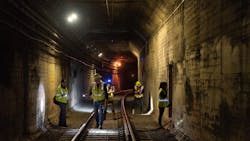SFMTA to start Twin Peaks Tunnel work
The San Francisco Municipal Transportation Agency (SFMTA) will begin work Nov. 30 on the Eureka Curve section of the Twin Peaks tunnel that connects downtown San Francisco to West Portal and beyond.
In 2019, SFMTA completed a major project in the Twin Peaks tunnel with seismic upgrades, major track and other infrastructure overhauls. Now, additional work in this crucial section of trackway needs to be done. This work is essential to improving the quality of the system and reducing the potential for disruptions to service in the years to come.
Starting the Monday after Thanksgiving, construction crews will begin maintenance work inside the Twin Peaks Tunnel going into the tunnel via the entrance on Market Street between Diamond and Collingwood Street. Planned work includes replacement of the overhead catenary system (OCS) splice connectors, overhead lines, track fasteners, rails, track ballast, switch machine, trackway adjustment throughout the tunnel, rail grinding, installation of new subway lights and several trackway and OCS tests. These are the key elements that keep trains running.
Work is planned for approximately three months, through February 2021. Crews will take a break for the holidays from Dec. 24 through New Year's Day. Construction is scheduled for Monday to Saturday, from 7:30 a.m. to 8:00 p.m. with hours subject to change based on construction needs. No night work will occur in the public right of way and will be limited to inside the tunnel.
As SFMTA performs this work, some parking will be temporarily restricted, and traffic lanes will be modified in the construction zone near Castro Station. This work is part of the Subway Renewal program that targets critical subway systems and infrastructure for strategic overhauls to improve system reliability and resilience. This work will improve the maintainability of the trackway. It will also provide a more solid foundation for service into the future.
Ballast replacement details
Ballast is the rocky bed beneath the tracks that stabilizes the trackway. Over time, the ballast wears and can become dusty as the larger rocks are broken down; these are called fines. Over time the number of fines increases, and the trackway can become muddy and difficult to maintain. During the 2019 Twin Peaks project, SFMTA reused rather than replaced the ballast in an attempt to save time and money. Unfortunately, the required procedural steps to ensure that the reused ballast would maintain its integrity through a thorough wash/filtering process was not followed. Looking back, SFMTA says it acknowledges these choices were an oversight.
The trackway is safe for operation right now, but the ballast has continued to degrade and will, over the long term, reduce the expected life of the new trackway if left unaddressed. In order to take advantage of the current closure of the subway and minimize future disruptions to service, SFMTA is moving ahead with the ballast replacement now.
SFMTA is currently working on a task order with a contractor to replace the ballast and improve the drainage in and around the Eureka Curve, and will have more details on cost in the coming weeks. The agency will not need to replace the track that was laid down in 2018, but will need to move it to remove and replace the ballast.
This issue also underscores two of the key areas SFMTA is targeting with the Subway Renewal program: improved project delivery and workforce culture. The agency says decision-making process that led to the reuse of the ballast in 2019 should have been interrogated more intensively and is committed to promoting a more open workplace that supports staff raising challenging questions during the course of projects to make sure the choices made are in the best interest of the system and of the public.
